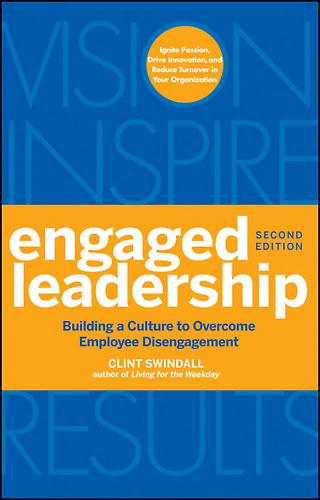- CONTENTS:
- Letter from the EditorArticle SummariesDedication and RemembranceEmploying the Seven Army Values to Win Hearts and MindsCommentary: The Business of Warfare: "Winning Hearts and Minds"Conflict Resolution: Cultural Understanding ImperativeThe Personal Values of School Leaders in Pakistan: A Contextual Model of Regulation and InfluenceThe Needs of the Stakeholders are the Seeds of Growth for the Organisation: Vignettes of Wisdom from Mr. G. NarayanaThe Character X Factor in Selecting Leaders: Beyond ethics, virtues, and valuesA Model for Implementing a Successful Sustainability StrategyEngaged Leadership: New Concept or Evolutionary in Nature?

- ENGAGED LEADERSHIP: NEW CONCEPT OR EVOLUTIONARY IN NATURE?

EDWARD WOODS III, M.P.A., REVIEWER
MICHIGAN DEPARTMENT OF HUMAN SERVICES
CONTACT CENTER DIRECTOR
GRAND LEDGE, MICHIGANIntroduction
Clint Swindall, author of Engaged Leadership, constructs a culture to achieve employee engagement. In reviewing his book, Swindall (2011) creates the fable for illustrations and provides a step-by-step process to show how to engage employees. This provides readers with two opportunities to comprehend and reinforce employee engagement.

Swindall emphasizes that more than 70 percent of employees fail to connect to their workplace. In targeting these disengaged workers, Swindall notes that these were not "bad people," but they perfunctorily engaged in routine cycle of coming to work to collect a paycheck. Although "bad people" lacked a precise definition, it could be implied that these disengaged employees did not abuse work time on personal matters or frequently called in sick because of their ennui. Nevertheless, the survey indicates that these employees, representing the overwhelming majority of the workforce, lacked motivation in their jobs.
Tuttle (2011) emphasizes in his recent Time Moneyland article that workers are frustrated with their bosses and not engaged in their jobs, but are staying because of the poor economy. Swindall believes that the poor economy elevates a fight for financial survival, but does not create employee engagement. At the very least, Tuttle, however, provides validity to the issue of causation of employee engagement.
Critiquing Engaged Leadership in relationship to leadership theories espoused by Bernard Bass (arguably one of the leading authorities on leadership theories), the question rises as to whether this book constitutes a new concept or evolves from existing leadership theories.
Organizational Culture
Swindall (2011) firmly believes that the responsibility for building an organizational culture of engagement is the sole responsibility of the leaders; that an uninformed employee is a disengaged employee; and that future organizational success depends on employee engagement. Instead of expecting employee engagement through osmosis, leaders need to be genuinely creative in demonstrating how their employees‘ contributions assist the organization in meeting its goals through sharing information. Leaders, who represent their respective companies to their employees, possess the unique and often underused powers to connect employees to their organizations in a meaningful manner to achieve organizational success and an engaged workforce.
"Most leaders are spending more time managing tasks and not nearly enough time leading people" (Swindall, p. 9). Leaders fail to engage employees because they are distracted managing the day-to-day affairs and not investing sufficient time in engaging their teams. In some instances, the managing of daily tasks utilizes Smartphones and other technologies as indirect tools of communication as opposed to the more humanistic and engaging face-to-face form of communication, thus thwarting an opportunity to directly engage the employees. This suggests that leaders prioritize the management of the workforce over leadership, obfuscating the connection of employee engagement to organizational success.
Using the fable as a teachable moment, Swindall portrays engaged leadership through Halfiax, a large call center company. Hannah Jaxson, director of Halifax‘s Call Center in central Texas, outlines the keys to employee engagement. Halifax views employee engagement ─ as shaped by informed leaders ─ as an integral component to garner organizational success. Swindall identifies directional leadership, motivational leadership, organizational leadership, and character core as the key components in building employee engagement.
Directional Leadership
Swindall (2011) delineates the four aspects of directional leadership as (1) recruiting support from the engaged employees; (2) preparing the organization for change; (3) informing the employees as to how they contribute to the company‘s success; and (4) routinely communicating progress to the workforce. With respect to the first element, the leader must acquire continuing support from the engaged employees not only to mold the direction of the company but to ensure that they do not join the ranks of the disengaged employees and possibly further destroying the company culture. Additionally, such engaged workers generate support to help guide the direction of the company as they were viewed as colleagues and peers ─ and not as management. This attribute is deemed paramount in exercising directional leadership.
"The transformational leader concretizes a vision that the followers view as worthy of their effort, thereby raising their arousal and effort levels" (Bass, p. 631). Bass, author of The Bass Handbook of Leadership, concurs with Swindall, but views directional leadership as vision. Both require leaders to engage their employees in a steadfast, meaningful way to secure such support and increase productivity. Although Swindall fails to directly reference Bass, Bass‘s work regarding vision is reflected in Engaged Leadership.
Motivational Leadership
According to Swindall, motivational leadership entails leading with positive motivation, celebrating small successes, encouraging life balance, and creating a fair work environment to inspire workers to pursue the company‘s vision. Whereas directional leadership speaks to vision, motivational leadership inspires employees to pursue and achieve that vision. Cleary, the "carrot versus the stick approach" reinforces the virtues of positive motivation.
Instead of waiting until the goal is accomplished, Swindall challenges leaders to identify milestones and then celebrate the success of these small, yet significant accomplishments in the pursuit to achieve company objectives. However, the need to achieve life balance must motivate leaders to be concerned about the whole of an employee‘s existence, e.g., monitoring the well-being of aging parents, enjoying family time, fostering spirituality, and seeking opportunities to develop hobbies and other interests. Finally, leaders create an equitable work environment by consistently bestowing rewards for superior performance and applying negative consequences for shoddy performance.
Bass (2011) identified inspirational leaders as those who build their employees‘ expectations through a vision and articulating how to accomplish it. Simply speaking, inspirational leaders motivated their employees to believe and achieve the impossible. This seemed strikingly similar to what Swindall calls motivational leadership. Here‘s another opportunity where Swindall missed referencing Bass‘s work.
Organizational Leadership
Swindall articulates the four components of organizational leadership as follows: (1) identifying and positioning the appropriate talent; (2) building an intergenerational bridge; (3) moving toward real empowerment; and (4) establishing a strategy to maintain success. Organizational leadership focuses on utilizing the skills, talents, and resources held by employees. In this manner, employees‘ individual successes are inextricably connected to the success of the business.
"In fact, the vast majority [of employees] don’t leave companies. They leave bosses" (Swindall, p. 178). These employees are not forfeiting inanimate companies, but rather choosing to sever their relationships with managers ─ real human beings who have failed to properly engage them. It is imperative that leaders learn the DNA of their personnel in order to deploy them correctly, keep them committed, and retain them. This reiterates the demand for leaders to lead, thereby cultivating a meaningful relationship with their employees, rather than merely manage.
Bass (2010) opines that leaders generate the mechanisms for cultural embedding and reinforcement. Employees look to leaders to understand and reflect organizational objectives. Leaders must generate employee empowerment rather than micromanage. Leaders undermine the collective workforce when derelict behavior is overlooked and promising performance is not rewarded. Leaders compromise their integrity when they arbitrarily reward instead of treating everyone respectfully. Once again, although not specifically mentioned, Swindall indirectly yet unmistakably relates Bass‘s theory of organizational leadership to his concept of organizational leadership.
Character Core
Character core represents the central ingredient binding directional, motivational, and organizational leadership. "I maintain that it doesn’t matter how good you are at the mechanics of leadership if the people in your organization question your character" (Swindall, p. 207). Character core validates engaged leadership. Without character, leaders will lack the followers who will trust and believe in them from a directional, motivational, or organizational leadership standpoint. Any known character flaw, either professional or personal, can compromise the ability for any leader to engage their employees.
In assessing the character flaws of elected officials, former U.S. Representative Anthony Weiner finally recognized the importance of character core when he resigned from office for sending inappropriate pictures of himself. Former U.S. Senator John Ensign and Governors Mark Sanford and Elliott Spitzer lost credibility for having extramarital affairs while in office and all ultimately resigned. Pastors have left their congregations due to criminal and sexual misconduct. Despite the tired and cyclical excuse of these activities being personal in nature, followers often fail to separate personal and professional integrity.
Bass (2008) maintains that principled leaders receive more favorable reviews from employees than leaders who were deemed ethically-neutral. Employees enjoy working for leaders whose ethics were clearly understood and communicated. They are not looking for leaders who were "politically correct," but rather ethically sound. Bass stresses the importance of ethical leadership, but Swindall appears to give it more credence by labeling it as character core, even though both terms appear synonymous.
Conclusion
Swindall best communicates the connecting dynamics of a work environment when he enshrouds the applications of engaged leadership in a fable. He devises a story that enables readers to identify with the characters and problems in the workplace. Readers notice their bosses or co-workers in the fable. They are also able to identify with the following situations of non-engagement: lack of direction in the organization, failure to recognize employee contributions, and showing bias to certain personnel.
Swindall gives accolades to other leadership consultants: James Collins, author of Good to Great, and John Maxwell, author of There’s No Such Thing as Business Ethics: Discover the One Rule for Making Decisions. Collins emphasizes the need to recruit the right people and place them in the right position to support Swindall‘s organizational leadership. Maxwell espouses Swindall‘s position that ethics are a personal issue, not a business, social, or political matter as it relates to character core.
However, Swindall was quite silent in connecting engaged leadership to a specific type of leadership theory to provide the opportunity for the reader to research and delve into a deeper study of this subject. This was evident in the missed opportunities to properly identify the quoted Gallop survey of employee disengagement and to reference any poll which attempts to ascertain any cost savings associated with engaged leadership.
In closing, Engaged Leadership could have done a better job of connecting its components (directional leadership, motivational leadership, organizational leadership, and character core) to existing scholarly work, e.g. Bernard Bass. Although Swindall enables an easy read, Engaged Leadership does not provide a revolutionary concept. In actuality, this book evolves from existing leadership theories identified by Bass in his book, The Bass Handbook of Leadership.
ReferencesBass, B.M. (2008). The Bass Handbook of Leadership. New York, NY: Free Press.
Swindall, C. (2011). Engaged Leadership. Hoboken, NJ: John Wiley & Sons, Inc.
Tuttle, B. (2011, June 20). Workplace Purgatory: Hating the Job, But Reluctant to Quit. Time Moneyland. Retrieved from http://moneyland.time.com/2011/06/20/workplace-purgatory-hating-the-job-but-reluctant-to-quit/
Author Biography
Edward Woods III is a Ph.D. student in the School of Public Affairs and Administration at Western Michigan University in Kalamazoo, Michigan. Serving in public administration for nearly 18 years, he directs the Contact Center for the Michigan Department of Human Services. Woods holds a B.A. from Oakwood University in Huntsville, Alabama and a M.P.A. from Western Michigan University.

